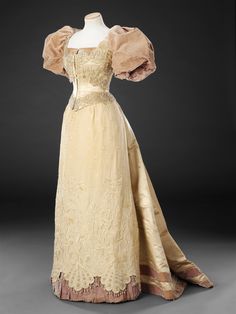I've wanted a Belle Epoque "Absinthe" ball gown for years.
Literally. Years.
To that end, I've been collecting green and gold luxe fabrics. For years. My best find ever was the bolts of two coordinating silks that I found at the much beloved - but lost - Colorado Fabrics. One bolt is deep forest green and the other is the same green striped with taupe. Also collected have been embroidered faux silks, a couple of saris, some upholstery fabric for facings - well, an entire box of bits, bobs, and findings.
The prospect of having a gorgeous gown is doing wonders for my mental state - I'm excited about it in a way that I haven't been excited about sewing for a very long time. (Maybe it's because of the Anaheim debacle, but that's a tale for another day.) One of the reasons that I've been interested in organizing another Victorian Ball is so we can have an elegant evening in beautiful attire.
And now the opportunity presents itself. Victorian Society of Colorado sponsors several balls each year, and one is approaching in just over 2 weeks. My friend Lara has constructed my corset, and has generously agreed to help with the fitting and sewing on this project. It's going to be a tight timeline, but we're spending next weekend on it, so I anticipate having a great deal of the structural work done in the next few days. That petticoat project is one initial piece, and I plan to have at least one done before the weekend work sessions; the corset and chemise are ready to go and the bloomers need some alterations.
I expect to have the next week plus to do embellishment on the gown; draping lace and making ribbon roses. I do wish that I had a dress form for this.
The design
The patterns that we are using are Truly Victorian TV 490, the 1892 Ballgown bodice, and TV 292, the 1893 Bell Skirt, which is the style that many Worth gowns employed. We'll be using the pouf sleeve as in the taupe gown below, to which will be added generous lace cuffs.To be clear, what I'm planning isn't a ballgown in the Belle Epoque sense. My colors are too dark for a ball gown, and I'm using considerable sleeves. Being older and not the size of a young lady, this would be recognizable as an "evening" gown in the 1890's; it's still perfectly acceptable for a lady of my stature to wear to a ball. We'll be following the basic form of the extant gowns pictured - the skirt and bodice of each of my different forest green silks, the arrangement depending on which I have more yardage of for the skirt. I think that I'll retain the bertha on the pink gown, use the sleeves on the taupe gown, and add generous lace cuffs as in the pink gown. I'm not sure if the sleeves should be solid silk or poufs of lace - or maybe lace overlaying the green silk - but I'm fond of lace.The large drapy bows on the pink gown will be replaced by swags of lace caught up with ribbon roses, and possibly over a contrasting faux underskirt as in the taupe gown, depending on available yardage. I'd like to place large draping bows on the sleeves and embellish with ribbon roses, but I'm frankly not sure how that's going to work with a bertha, so there will be some trial and error.
The pink gown seems to be worn with a corselet, so I'll be making one of those using TV 492, maybe lace-facing some of the solid green silk. It could match the sleeves.
I'm having a bit of a challenge finding the lace - this is not the usual JoAnn's fare. I had the perfect stuff picked out only to find that it's out of stock. I scoured Etsy and Ebay for a solution and ended up buying two (and spending far too much money), in the hope that one will show up on time. One piece is 3 yards of an embroidered ivory tulle, both edges bearing V-shaped lace edging so that's 6 yards of "trim". It's coming from China so my hopes are higher than my expectations. (Maybe it eventually becomes trimming for a fancy shirtwaist.) The other piece is 4 yards of a champagne embroidered mesh, edged with scallops and arabesques. It is coming from Los Angeles, so I expect it to arrive this week.About dress accessories
Dress accessories will be assembled based on the theme of the event - both a Steampunk and a more historic set for the appropriate venues. A pair of fancy brooches to catch up the bertha in front, one Victorian, one Steampunk. A elaborate Steampunk necklace, or a cascade of pearls. My fancy fan holder will suit for both environs, but I'm looking for a fan that isn't Battenberg lace and isn't white or black. Hair dressing will be a French twist with a high crown, and embellished with flowers, pearls, combs, or feathers. I'll use scrap to make a matching reticule. And perhaps a pair of "green fairy" wings for Steampunk events.
I'll detail progress in a later blog entry.





